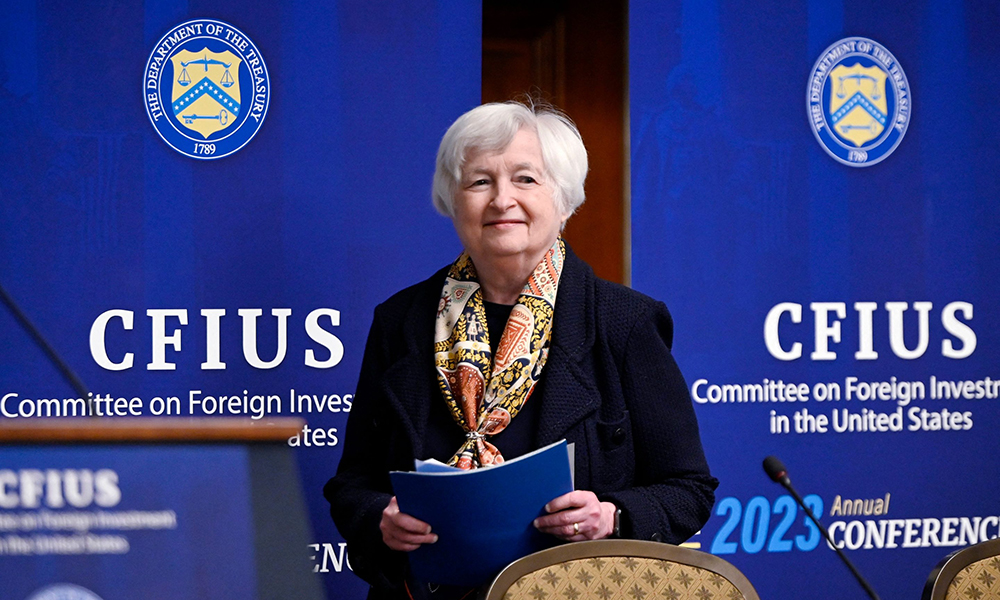
美國國債的規(guī)模已經(jīng)接近33萬億美元了,,但美國財(cái)政部部長珍妮特·耶倫目前似乎并不擔(dān)心這個(gè)問題,。9月18日,她提到了一個(gè)重要的統(tǒng)計(jì)數(shù)據(jù),,以此試圖讓人們相信美國政府持續(xù)增長的債務(wù)負(fù)擔(dān)仍然是可控的,。
耶倫在9月18日接受美國消費(fèi)者新聞與商業(yè)頻道(CNBC)采訪時(shí)表示:“在判斷財(cái)政工作形勢時(shí),我最經(jīng)常關(guān)注的一個(gè)統(tǒng)計(jì)指標(biāo)就是凈利息占GDP的比重,?!贝颂幍摹皟衾ⅰ笔侵该绹?lián)邦政府的債務(wù)利息凈支出占美國GDP的比重?!凹词刮覀兛吹嚼视兴仙?,但這個(gè)指標(biāo)仍然保持在一個(gè)非常合理的水平,。”
在耶倫看來,,2022年,,美國聯(lián)邦政府的利息支出約占GDP的1.86%,此數(shù)據(jù)出自美聯(lián)儲(Federal Reserve),。這與1960年以來略低于2%的歷史平均水平是基本一致的,。

耶倫稱,目前她仍然“并不真正擔(dān)心”近期的聯(lián)邦支出項(xiàng)目會(huì)導(dǎo)致財(cái)政赤字——例如用于補(bǔ)貼半導(dǎo)體生產(chǎn)與研發(fā)的《芯片與科學(xué)法案》(CHIPS and Science Act),,用于修橋修路的《基礎(chǔ)設(shè)施投資與就業(yè)法案》(Infrastructure Investment and Jobs Act),,等等。她認(rèn)為,,聯(lián)邦政府只需要“確保我們具有可持續(xù)發(fā)展的能力”,。
不過,美國國會(huì)預(yù)算辦公室(Congressional Budget Office)在今年6月的一份報(bào)告里警告道,,如果利率與國債持續(xù)上漲下去,,到2053年,美國聯(lián)邦政府的凈利息支出占GDP的比重就將達(dá)到6.7%,。
“如此之高且仍然在不斷上升的政府債務(wù)將減緩經(jīng)濟(jì)增長的速度,抬高美債的外國債權(quán)人的利息收入,,并對美國的財(cái)政和經(jīng)濟(jì)前景造成重大風(fēng)險(xiǎn),,這也可能導(dǎo)致立法者在政策選擇上更加束手束腳?!痹搱?bào)告的作者解釋道,。
有些批評人士對美債規(guī)模持續(xù)走高的潛在風(fēng)險(xiǎn)給出了更嚴(yán)厲的警告。比如對沖基金Universa Investments的創(chuàng)始人馬克·施皮茨納格爾在今年8月告訴《財(cái)富》雜志,,美國正在經(jīng)歷“人類歷史上最大的信貸泡沫”,。
“我們從未見過金融體系中出現(xiàn)過如此之高的總體債務(wù)和杠桿水平。這是個(gè)實(shí)驗(yàn),,但我們都知道信貸泡沫總有被刺破的一天,。我們不知道這一天會(huì)在何時(shí)到來,但它總有到來的一天,?!?/p>
施皮茨納格爾指出,今年第二季度,,美國民間債務(wù)總體規(guī)模達(dá)到了創(chuàng)紀(jì)錄的17萬億美元,,其中,非住房債務(wù)達(dá)到了4.7萬億美元的歷史最高水平,。據(jù)美聯(lián)儲的數(shù)據(jù),,算起來,,美國的總債務(wù)水平已經(jīng)達(dá)到了GDP的120%。
耶倫在9月18日接受采訪時(shí)也承認(rèn),,將來聯(lián)邦政府“必須確?!必?cái)政赤字可控,否則國債就將成為美國經(jīng)濟(jì)的一個(gè)大問題,。
“當(dāng)然,,大幅削減赤字也是一個(gè)具有可能性的目標(biāo)?!彼a(bǔ)充道:“拜登總統(tǒng)已經(jīng)提出了一系列逐步降低財(cái)政赤字,,同時(shí)對經(jīng)濟(jì)進(jìn)行投資的措施,這些就是我們將來需要做的事情,?!?/p>
談汽車工人罷工
在采訪中,耶倫還被問到了美國汽車工人聯(lián)合會(huì)(United Auto Workers)的罷工問題,,這場罷工同時(shí)影響了底特律的三大汽車巨頭——福特(Ford),、通用汽車(GM)和Stellantis,并且引起了經(jīng)濟(jì)學(xué)家和投資者的關(guān)注,。耶倫表示,,她希望美國汽車工人聯(lián)合會(huì)和三巨頭盡快達(dá)成一份“雙贏協(xié)議”,但她拒絕在現(xiàn)階段討論此次罷工對經(jīng)濟(jì)的潛在影響,。
“我認(rèn)為現(xiàn)在預(yù)言它對經(jīng)濟(jì)的影響還為時(shí)過早,。這在很大程度上要取決于罷工持續(xù)多久,以及有多少人會(huì)受到它的影響,?!彼f。
受新冠疫情影響,,很多企業(yè)之前都遭遇了用工荒,,因此美國就業(yè)市場也出現(xiàn)了連續(xù)幾年的強(qiáng)勁態(tài)勢。但在9月18日,,耶倫承認(rèn),,目前美國就業(yè)市場上的招聘熱度正在降溫。不過總體來看,,雖然罷工和美債上漲都給經(jīng)濟(jì)造成了潛在威脅,,但耶倫認(rèn)為,美國經(jīng)濟(jì)當(dāng)前的總體走勢仍然強(qiáng)勁,。
“我們的勞動(dòng)力市場仍然是良好的,、健康的,消費(fèi)支出和工業(yè)生產(chǎn)也依然保持強(qiáng)勁,。我沒有看到任何跡象表明經(jīng)濟(jì)有下行風(fēng)險(xiǎn),。對于經(jīng)濟(jì)來說,,勞動(dòng)力市場保持強(qiáng)勁,通脹水平下降,,經(jīng)濟(jì)持續(xù)走強(qiáng),,這是最理想的情況了,而這也是我們當(dāng)前正在看到的情況,?!保ㄘ?cái)富中文網(wǎng))
譯者:樸成奎
美國國債的規(guī)模已經(jīng)接近33萬億美元了,但美國財(cái)政部部長珍妮特·耶倫目前似乎并不擔(dān)心這個(gè)問題,。9月18日,,她提到了一個(gè)重要的統(tǒng)計(jì)數(shù)據(jù),以此試圖讓人們相信美國政府持續(xù)增長的債務(wù)負(fù)擔(dān)仍然是可控的,。
耶倫在9月18日接受美國消費(fèi)者新聞與商業(yè)頻道(CNBC)采訪時(shí)表示:“在判斷財(cái)政工作形勢時(shí),,我最經(jīng)常關(guān)注的一個(gè)統(tǒng)計(jì)指標(biāo)就是凈利息占GDP的比重?!贝颂幍摹皟衾ⅰ笔侵该绹?lián)邦政府的債務(wù)利息凈支出占美國GDP的比重,。“即使我們看到利率有所上升,,但這個(gè)指標(biāo)仍然保持在一個(gè)非常合理的水平,。”
在耶倫看來,,2022年,,美國聯(lián)邦政府的利息支出約占GDP的1.86%,此數(shù)據(jù)出自美聯(lián)儲(Federal Reserve),。這與1960年以來略低于2%的歷史平均水平是基本一致的。
耶倫稱,,目前她仍然“并不真正擔(dān)心”近期的聯(lián)邦支出項(xiàng)目會(huì)導(dǎo)致財(cái)政赤字——例如用于補(bǔ)貼半導(dǎo)體生產(chǎn)與研發(fā)的《芯片與科學(xué)法案》(CHIPS and Science Act),,用于修橋修路的《基礎(chǔ)設(shè)施投資與就業(yè)法案》(Infrastructure Investment and Jobs Act),等等,。她認(rèn)為,,聯(lián)邦政府只需要“確保我們具有可持續(xù)發(fā)展的能力”。
不過,,美國國會(huì)預(yù)算辦公室(Congressional Budget Office)在今年6月的一份報(bào)告里警告道,,如果利率與國債持續(xù)上漲下去,到2053年,,美國聯(lián)邦政府的凈利息支出占GDP的比重就將達(dá)到6.7%,。
“如此之高且仍然在不斷上升的政府債務(wù)將減緩經(jīng)濟(jì)增長的速度,抬高美債的外國債權(quán)人的利息收入,,并對美國的財(cái)政和經(jīng)濟(jì)前景造成重大風(fēng)險(xiǎn),,這也可能導(dǎo)致立法者在政策選擇上更加束手束腳,。”該報(bào)告的作者解釋道,。
有些批評人士對美債規(guī)模持續(xù)走高的潛在風(fēng)險(xiǎn)給出了更嚴(yán)厲的警告,。比如對沖基金Universa Investments的創(chuàng)始人馬克·施皮茨納格爾在今年8月告訴《財(cái)富》雜志,美國正在經(jīng)歷“人類歷史上最大的信貸泡沫”,。
“我們從未見過金融體系中出現(xiàn)過如此之高的總體債務(wù)和杠桿水平,。這是個(gè)實(shí)驗(yàn),但我們都知道信貸泡沫總有被刺破的一天,。我們不知道這一天會(huì)在何時(shí)到來,,但它總有到來的一天?!?/p>
施皮茨納格爾指出,,今年第二季度,美國民間債務(wù)總體規(guī)模達(dá)到了創(chuàng)紀(jì)錄的17萬億美元,,其中,,非住房債務(wù)達(dá)到了4.7萬億美元的歷史最高水平。據(jù)美聯(lián)儲的數(shù)據(jù),,算起來,,美國的總債務(wù)水平已經(jīng)達(dá)到了GDP的120%。
耶倫在9月18日接受采訪時(shí)也承認(rèn),,將來聯(lián)邦政府“必須確?!必?cái)政赤字可控,否則國債就將成為美國經(jīng)濟(jì)的一個(gè)大問題,。
“當(dāng)然,,大幅削減赤字也是一個(gè)具有可能性的目標(biāo)?!彼a(bǔ)充道:“拜登總統(tǒng)已經(jīng)提出了一系列逐步降低財(cái)政赤字,,同時(shí)對經(jīng)濟(jì)進(jìn)行投資的措施,這些就是我們將來需要做的事情,?!?/p>
談汽車工人罷工
在采訪中,耶倫還被問到了美國汽車工人聯(lián)合會(huì)(United Auto Workers)的罷工問題,,這場罷工同時(shí)影響了底特律的三大汽車巨頭——福特(Ford),、通用汽車(GM)和Stellantis,并且引起了經(jīng)濟(jì)學(xué)家和投資者的關(guān)注,。耶倫表示,,她希望美國汽車工人聯(lián)合會(huì)和三巨頭盡快達(dá)成一份“雙贏協(xié)議”,但她拒絕在現(xiàn)階段討論此次罷工對經(jīng)濟(jì)的潛在影響。
“我認(rèn)為現(xiàn)在預(yù)言它對經(jīng)濟(jì)的影響還為時(shí)過早,。這在很大程度上要取決于罷工持續(xù)多久,,以及有多少人會(huì)受到它的影響?!彼f,。
受新冠疫情影響,很多企業(yè)之前都遭遇了用工荒,,因此美國就業(yè)市場也出現(xiàn)了連續(xù)幾年的強(qiáng)勁態(tài)勢,。但在9月18日,耶倫承認(rèn),,目前美國就業(yè)市場上的招聘熱度正在降溫,。不過總體來看,雖然罷工和美債上漲都給經(jīng)濟(jì)造成了潛在威脅,,但耶倫認(rèn)為,,美國經(jīng)濟(jì)當(dāng)前的總體走勢仍然強(qiáng)勁。
“我們的勞動(dòng)力市場仍然是良好的,、健康的,,消費(fèi)支出和工業(yè)生產(chǎn)也依然保持強(qiáng)勁。我沒有看到任何跡象表明經(jīng)濟(jì)有下行風(fēng)險(xiǎn),。對于經(jīng)濟(jì)來說,,勞動(dòng)力市場保持強(qiáng)勁,通脹水平下降,,經(jīng)濟(jì)持續(xù)走強(qiáng),,這是最理想的情況了,而這也是我們當(dāng)前正在看到的情況,?!保ㄘ?cái)富中文網(wǎng))
譯者:樸成奎
The U.S. national debt is nearing $33 trillion, but Janet Yellen isn’t worried just yet. The Treasury Secretary pointed to a key statistic on September 18 that, she believes, illustrates that the federal government’s growing debt burden remains under control.
“The statistic or metric that I look at most often to judge our fiscal course is net interest as a share of GDP,” she told CNBC on September 18, referring to the net payments the federal government makes on its debt relative to U.S. gross domestic product. “And even with the rise we have seen in interest rates that remains at a very reasonable level.”
To Yellen’s point, the federal government’s interest payments represented 1.86% of GDP in 2022, according to Federal Reserve data. That’s in line with the historical average since 1960 of just under 2%.
Yellen said she is still “not really concerned about the impact” that recent federal spending programs—including the CHIPS and Science Act that subsidizes semiconductor production and research and the Infrastructure Investment and Jobs Act that authorizes spending on roads, bridges, and other infrastructure projects—will have on the national deficit, arguing the federal government just needs “to make sure that we stay on a sustainable course.”
Still, the Congressional Budget Office warned in a June report that higher interest rates and the mounting national debt could lead the federal government’s net interest payments to spike to 6.7% of GDP by 2053.
“Such high and rising debt would slow economic growth, push up interest payments to foreign holders of U.S. debt, and pose significant risks to the fiscal and economic outlook; it could also cause lawmakers to feel more constrained in their policy choices,” the report’s authors explained.
Some critics have gone a step further in their warnings about the potential impact of an increasingly indebted U.S. government. Mark Spitznagel, founder of the hedge fund Universa Investments, told Fortune in August that we’re living through the “greatest credit bubble in human history.”
“We’ve never seen anything like this level of total debt and leverage in the system. It’s an experiment,” he said. “But we know that credit bubbles have to pop. We don’t know when, but we know they have to.”
Spitznagel pointed out that total public household debt hit a record $17 trillion in the second quarter, with non-housing debt hitting an all-time high $4.7 trillion, and the U.S. debt to GDP ratio was 120%, according to Federal Reserve data.
Yellen did admit on September 18 that, moving forward, the federal government will need to “make sure” to keep deficits under control, otherwise the national debt could become an issue.
“Certainly greater deficit reduction is possible,” she added. “The President has proposed a series of measures that would reduce our deficits over time, while investing in the economy and this is something we need to do going forward.”
The United Auto Workers’ strike
The Treasury Secretary was also asked about the United Auto Workers’ (UAW) strike that has affected Detroit’s Big Three—Ford, GM, and Stellantis—and begun to concern economists and investors. She said that she hoped the UAW and the Big Three would come to a “win-win agreement” as soon as possible and refused to discuss any potential impact to the economy at this stage.
“I think it’s premature to be making forecasts about what it means for the economy. It would depend very much on how long the strike lasts and exactly who is affected by it,” she said.
After years of almost unprecedented strength in the labor market during the pandemic when businesses struggled to find talent, Yellen admitted that hiring is cooling on September 18. But overall, despite the threat of workers’ strikes and a rising national debt, she said that she believes the economy remains strong.
“Look, we still have a good, healthy labor market. Consumer spending remains quite robust. We’ve seen strong industrial production. I don’t see any signs that the economy is at risk of a downturn,” she said. “This is the best of all worlds to see continued strength in the economy, a good strong labor market, and inflation moving down, and this is what we’re seeing.”






